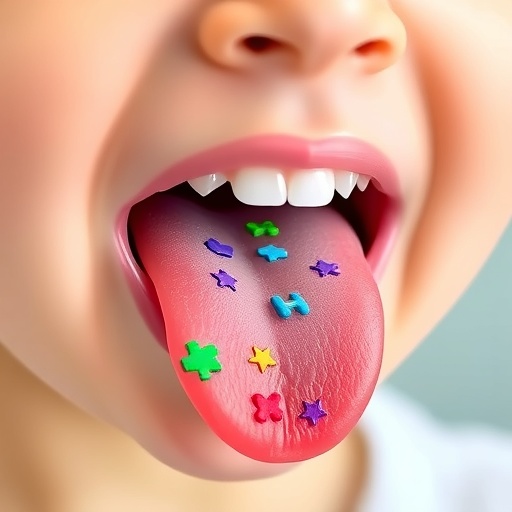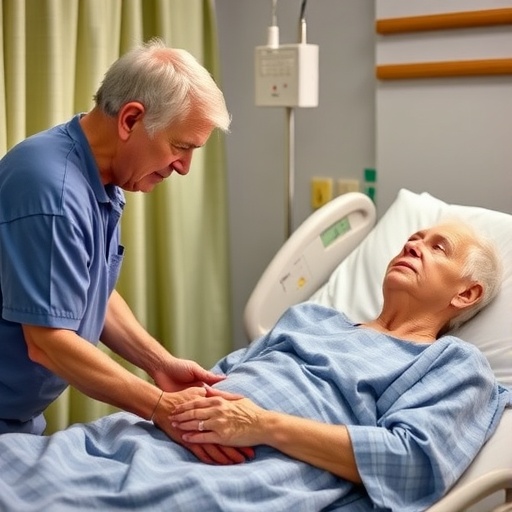A groundbreaking study has shed light on an intriguing aspect of pediatric autism treatment by examining the relationship between tongue-coating microbiota and the efficacy of washed microbiota transplantation (WMT). Conducted by a collaborative team led by researchers including Wu, Lu, and Wang, this comprehensive investigation delves into how the unique composition of microbiota in children with autism can serve as a predictive biomarker, offering hope for more targeted and effective therapeutic interventions.
The foundation of this research lies in understanding the gut-brain axis—a complex communication network linking the gastrointestinal system and the brain. This connection is increasingly recognized as pivotal in various neurodevelopmental disorders, including autism. While several studies have explored the gut microbiome’s role in these conditions, this current research takes a novel approach by focusing on the tongue-coating microbiota, providing fresh insights into diagnosing and predicting treatment outcomes for pediatric patients.
Traditionally, microbiota studies have targeted stool samples as the primary source for understanding gut flora. However, the significance of other microbiota, such as those found in the mouth, has often been overlooked. This research promptly addresses that gap, positing that tongue-coating microbiota could be a more accessible and less invasive method to assess microbial diversity in children with autism. The implications of such findings not only promise easier diagnostics but also the potential for earlier and more personalized treatments.
In their findings, the researchers discovered distinct microbial signatures in the tongue-coating samples of autistic children. These signatures correlated with clinical features observed in the patients, including behavioral symptoms and gastrointestinal issues commonly associated with autism. By identifying specific microbial compositions that appear consistently among this population, the study underlines a significant advancement toward personalized medicine, suggesting that these unique markers could facilitate tailored therapeutic approaches based on individual microbiota profiles.
Additionally, the study meticulously connects the dots between clinical features and the microbiota present in the subjects. For instance, children exhibiting more pronounced gastrointestinal symptoms often displayed unique microbiome configurations in their tongue coatings. This crucial link not only enhances the understanding of autism’s multifaceted nature but also reinforces the argument for considering microbial health as a vital component of holistic patient assessments.
Washed microbiota transplantation has emerged as a promising therapeutic option for a variety of gastrointestinal disorders and is now being explored in the realm of neurodevelopmental disorders, particularly autism. The researchers in this study argue compellingly for the role of tongue-coating microbiota as a biomarker for predicting WMT efficacy, suggesting that by assessing the microbial landscape before and after the procedure, clinicians could better anticipate treatment outcomes.
Moreover, the research highlights that while the concept of microbiota and its influence on human health is well-established, the specificity of microbiota profiles related to pediatric autism is just beginning to be unpacked. This study serves as a critical stepping stone, paving the way for subsequent research to explore how these microbial patterns might be altered through dietary changes, probiotics, or other interventions. By modifying tongue-coating microbiota, it may be possible to enhance the efficacy of treatments like WMT.
As the scientific community delves deeper into the intricacies of the microbiome, the integration of multi-omic approaches—analyzing not just the microbiota but also metabolomics, transcriptomics, and proteomics—could vastly improve our understanding of how these microbial communities influence behavior and neurodevelopment. The holistic view of autism, as proposed in this study, opens avenues for integrative medical practices that could harmonize traditional therapies and cutting-edge microbiome science.
Interestingly, the study encourages a broader dialogue on the implications of oral health in neurodevelopment. Children with autism often have coexisting oral health issues, which could influence the composition of microbial populations in the mouth. This relationship underscores the necessity for interdisciplinary approaches where pediatricians, dentists, and nutritionists collaborate to provide comprehensive care tailored to this vulnerable population.
As researchers strive to replicate and build upon these findings, the potential for tongue-coating microbiota to feature in routine assessments could revolutionize how pediatric autism is approached within clinical settings. As a non-invasive biomarker, it provides an avenue for continual monitoring, enabling clinicians to adjust treatment plans dynamically and responsively.
Furthermore, the study’s authors emphasize the reproducibility of their findings in diverse populations, highlighting the global relevance of their work. Autism is a spectrum with a wide range of manifestations, and geographical and cultural differences can influence microbiota. Thus, understanding these variables could enhance the generalization of their findings, solidifying the role of tongue-coating microbiota as a vital tool in autism treatment efficacy.
Given the continuously expanding research on the microbiome, it is clear that interdisciplinary collaboration will be crucial in unlocking further insights. By integrating microbiology, neuroscience, pathology, and nutritional science, researchers can create a more comprehensive understanding of autism and related conditions, leading to groundbreaking therapeutic innovations.
Ultimately, this revelatory work underscores a significant advancement in the quest for personalized medicine in autism treatment. With its focus on tongue-coating microbiota as a predictive biomarker, the study not only illustrates a pathway towards more effective interventions but also highlights the essential role of microbiota in understanding and potentially mitigating neurodevelopmental disorders among the pediatric population. As the scientific community embraces this fresh perspective, parents and clinicians alike await the promising developments that could follow.
The findings of this study stand to redefine clinical practices, setting the stage for a future where microbiota profiling becomes standard in the management of autism. By embracing this paradigm shift, healthcare providers can ensure that children receive the most appropriate and effective treatments tailored to their unique microbiotic make-up—significantly enhancing the quality of life for those affected by autism.
In conclusion, this research marks a pivotal moment in autistic spectrum disorder exploration, as it opens new fronts not only in diagnosis and treatment but in our understanding of the relationship between the microbiome and neurological health. As more pieces of this puzzle come together, we move closer to unraveling the complexities of pediatric autism, one microbial signature at a time.
Subject of Research: Tongue-coating microbiota as a predictive biomarker of washed microbiota transplantation efficacy in pediatric autism.
Article Title: Tongue-coating microbiota as a predictive biomarker of washed microbiota transplantation efficacy in pediatric autism: integration with clinical features.
Article References: Wu, C., Lu, J., Wang, Y. et al. Tongue-coating microbiota as a predictive biomarker of washed microbiota transplantation efficacy in pediatric autism: integration with clinical features. J Transl Med 23, 1037 (2025). https://doi.org/10.1186/s12967-025-07001-4
Image Credits: AI Generated
DOI: 10.1186/s12967-025-07001-4
Keywords: pediatric autism, tongue-coating microbiota, washed microbiota transplantation, microbiome, gut-brain axis, biomarkers, personalized medicine.
Tags: gut-brain axis in autisminnovative autism treatment strategiesmicrobial diversity in childrenmicrobiome research in neurodevelopmental disordersmicrobiota and autismnon-invasive microbiota assessmentoral microbiota significancepediatric autism treatmentpredictive biomarkers for autismtherapeutic interventions for autismtongue-coating microbiotawashed microbiota transplantation





